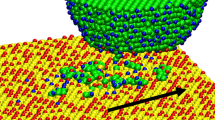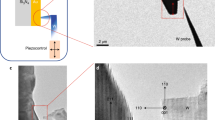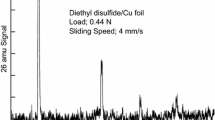Abstract
Predictions from molecular dynamics (MD) simulations, that sliding at a metal–metal interface causes vortices in the near-surface region that transport atoms from the surface into the subsurface region, is tested experimentally. This is accomplished by rubbing a methyl thiolate overlayer grown on a clean copper foil by exposure to dimethyl disulfide at room temperature. Repeatedly rubbing a 1.27 × 10−2 m diameter pin over a thiolate-covered copper surface at an applied load of 0.44 N and sliding speed of 4 × 10−3 m/s in an ultrahigh vacuum tribometer, results in the removal of sulfur from the wear track as measured using spatially resolved Auger spectroscopy. Any remaining surface species, in particular, outside the wear track, are removed by argon ion bombardment. Since sulfur is more thermodynamically stable at the surface, heating the sample causes the sulfur to resegregate to the surface only inside the wear track, thereby directly confirming the predictions from MD simulations.



Similar content being viewed by others
References
Persson, B.N.J.: Sliding Friction: Physical Principles and Applications, 2nd edn. Springer, Heidelberg (2000)
Persson, B.N.J.: Theory and simulations of sliding friction. Phys. Rev. Lett. 71, 1212 (1993)
Rigney, D.A., Hammerberg, J.E.: Unlubricated sliding behavior of metals. MRS Bull. 23, 32 (1998)
Emge, A., Karthikeyan, S., Kim, H.J., Rigney, D.A.: The effect of sliding velocity on the tribological behavior of copper. Wear 263, 614 (2007)
Hardy, W.B.: Collected Scientific Papers of Sir William Bate Hardy. Cambridge University Press, Cambridge (1936)
Jacobson, S., Hogmark, S.: Surface modifications in tribological contacts. Wear 266, 370 (2009)
Karthikeyan, S., Kim, H.J., Rigney, D.A.: Velocity and strain-rate profiles in materials subjected to unlubricated sliding. Phys. Rev. Lett. 95, 106001 (2005)
Kim, H.J., Emge, A., Winter, R.E., Keightley, P.T., Kim, W.K., Falk, M.L., Rigney, D.A.: Nanostructures generated by explosively driven friction: experiments and molecular dynamics simulations. Acta Mater. 57, 5270 (2009)
Kim, H.J., Karthikeyan, S., Rigney, D.: The effects of sliding velocity and sliding time on nanocrystalline tribolayer development and properties in copper. Wear 267, 562 (2009)
Kim, H.J., Kim, W.K., Falk, M.L., Rigney, D.A.: MD simulations of microstructure evolution during high-velocity sliding between crystalline materials. Tribol. Lett. 28, 299 (2007)
Hughes, D.A., Hansen, N.: Graded nanostructures produced by sliding and exhibiting universal behavior. Phys. Rev. Lett. 87, 135503 (2001)
Stachowiak, G.W., Batchelor, A.W.: Engineering Tribology. Butterworth-Heinemann, Oxford (2001)
Wu, G., Gao, F., Kaltchev, M., Gutow, J., Mowlem, J., Schramm, W.C., Kotvis, P.V., Tysoe, W.T.: An investigation of the tribological properties of thin KCl films on iron in ultrahigh vacuum: modeling the extreme-pressure lubricating interface. Wear 252, 595 (2002)
Furlong, O.J., Miller, B.P., Li, Z., Walker, J., Burkholder, L., Tysoe, W. T. The surface chemistry of dimethyl disulfide on copper. Langmuir. (2010). doi:10.1021/La101769y
Kondoh, H., Nozoye, H.: Effects of electron irradiation on methylthiolate monolayer on Au(111): electron-stimulated desorption. J. Phys. Chem. B 102, 2367 (1998)
Lara, J., Blunt, T.J., Kotvis, P., Riga, A., Tysoe, W.T.: Surface chemistry and extreme-pressure lubricant properties of dimethyl disulfide. J. Phys. Chem. B 102, 1703 (1998)
Furlong, O.J., Gao, F., Kotvis, P., Tysoe, W.T.: Understanding the tribological chemistry of chlorine-, sulfur- and phosphorus-containing additives. Trib. Int. 40, 699 (2008)
Acknowledgment
This work was supported by the National Science Foundation under Grant number CHE-0654276 and the Office of Naval Research.
Author information
Authors and Affiliations
Corresponding author
Rights and permissions
About this article
Cite this article
Furlong, O.J., Miller, B.P. & Tysoe, W.T. Shear-Induced Surface-to-Bulk Transport at Room Temperature in a Sliding Metal–Metal Interface. Tribol Lett 41, 257–261 (2011). https://doi.org/10.1007/s11249-010-9711-4
Received:
Accepted:
Published:
Issue Date:
DOI: https://doi.org/10.1007/s11249-010-9711-4




